How to Use Flameware Cookware
SEASONING OR PREPARATION FOR COOKING
A frequent question is “How do I use Flameware Cookware?”
You’ll find it is easier to use than any other type of clay cookware.
No “seasoning” or other preparation is needed. Use it just as you get it.
No soaking. No boiling or baking with water, oil or milk as there usually is with earthenware.
IT’S BASICALLY NON-STICK BUT WITH NO COATING. USE ANY UTENSIL YOU HAVE
A light spray or wipe with olive oil or cooking oil will prevent most sticking. The glaze is essentially glass.
Over time the glaze builds up an oil “finish” just like a cast iron pan. I do an omelet every day in a skillet and wipe clean.
HEATING WITH YOUR FLAMEWARE POT
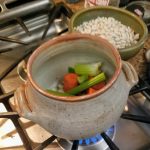
While most cooking will take place at medium, unlike other clay pots, there is
no need to be “gentle” with your new pot. Turn the flame to where you expect
to be cooking and put the pot on. Thermal Shock is a thing of the past.
But, as noted above, cooking with all clay pots has its own rhythm.
WHAT DO YOU DIFFERENTLY?
The main difference is that clay is an insulator. In both Flameware and earthenware heat will come through where you put it. Cooking on a coil burner electric, for instance, if you leave the pot in one place too much, you will begin to see a darkening where the coil is most. Move the pot around to even out the heating. Or use some liquid, water, wine, stock or broth, early in the cooking process. The liquid helps spread the heat.
You can use a flame spreader, but it’s not necessary for any type of stove including glass-top stoves. For induction stoves, you will need the metal induction plate that came with the stove, or is available in kitchen stores. It converts the Induction wave energy to heat.
SLOW DOWN! GET USED TO A NEW RHYTHM TO YOUR COOKING
It will take a few minutes for the pot to come up to heat, or to cool off when heat is removed. DO NOT turn the heat way up, planning to back it off as the heat comes up. By the time you see the effects of the heat, it is already going to surge past the temperature you want. The rule I use is that once the heat goes in, it comes through to the food.
If you find foods are burning, it’s a sure sign you’re using too high an initial setting. This same is true of earthenware clay cooking pots. ( I have heard it suggested the reason people invented wine, was to have something to do while their clay pot heated up!)
CLEAN-UP
If you’ve controlled heat, there should be very little burning. If something does scorch, clean with any kind of scrubby you have, plastic, metal or scouring powder. The glaze is glass and won’t scratch.
As soon as yo0u’re done cooking, you can place the hot pot directly under water. It will actually help clean-up
If you do get some burned on food, (it does happen), soak in a liquid detergent, clean the pan with the scrubby. If that doesn’t get it, spray with EZ-Off or other oven cleaner. Use as directed, don’t breathe the fumes, let it sit 20 minutes or so, and scrubby it off. Then rinse and dry normally. If it fits, you can certainly put your Flameware in the dishwasher. I wash gently to avoid disturbing the slight oil coating.
Flameware will not mold like earthenware if you put it away damp. Flameware is not porous so it doesn’t hold food residue or moisture which can cause mold.
WHAT ELSE? UTENSILS, DARKENING WITH USE, DON’T DROP ME!
You can use any of your favorite utensils: wood, plastic, silicon and metal.
The glaze will darken a bit over time from oils that get in the pores of the glaze.
You will get some carbon darkening around the bottom, especially if you use gas. Don’t worry about it.
Don’t drop it. While flameware is less brittle than stoneware, it is ceramic and doesn’t take kindly to floors or hard knocks.
The handle is a bit fragile hanging out there. Avoid hitting it accidentally.
If it breaks, it can’t be glued because glues and epoxies won’t take the heat.
The handle won’t get hot unless flame is directly applied to it or creeps around the bottom. Grill pans and pieces
used in the oven, will get hot.
How Your NewClay Pottery Flameware Has Been Tested
After being put in the freezer overnight, it is put on a full gas flame, heated to 5-600 degF and then plunged in
an ice-water bath. If it will take this, it is Flameware All Ceramic Stovetop Cookware. Guaranteed.
I don’t recommend you do this, but it will take it.
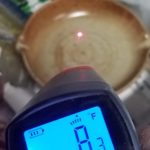
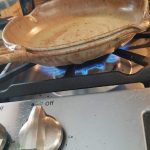
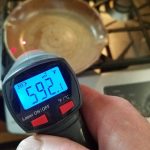
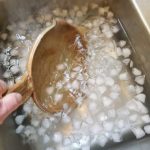

I was wondering if you do custom style pots of flame ware. I’ve been looking for a potter who can make me historically accurate german shaped pots.
Thanks for your inquiry regarding my ability to duplicate historic German pottery in clay. The first thing is to make sure we’re talking about the same clay. The flameware I work with is not earthenware, which is frequently incorrectly referred to as flame ware. ;
The flameware I use and refer to, is a clay body developed in the 1970’s by a professor at Alfred University in New York state.
It is a highfire (Cone 10) formula designed to withstand high direct heat on a modern stove. The ancient earthenware clay was naturally mined, generally a pure clay and would take direct flame, but only at low levels such as small open fires, wood stoves and charcoal.
By your request for historically accurate work, it would have to be earthenware, typically fired from cone 05 to cone 4 and typically handbuilt since few earthenware clays are very good for throwing. If they are glazed, it would take completely different glazing than the flameware I work with.
So, I fear I’m not going to be much help and I know of no one personally who could undertake this. There might be some FaceBook groups that specialize in discussions like this, or there are several general clay groups and posting your request there might find you a lead in your quest.
Good luck, it sounds like an interesting project.